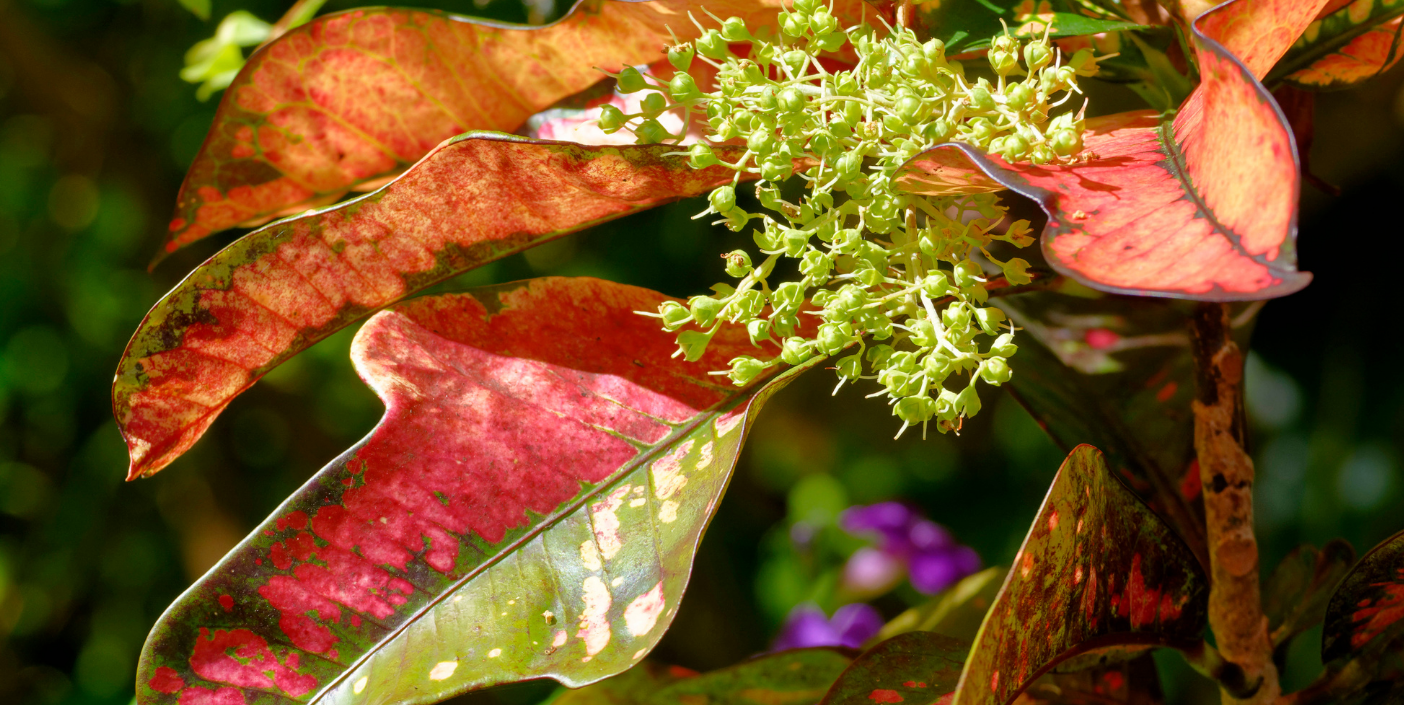
Does your yard need a little pizzaz?
You could, of course, plant annual flowers, and enjoy an instant burst of color. But, alas, the blooms are fleeting, and in relatively short order, you’ll be back at the nursery buying another round.
Don’t misunderstand; we love our flowers! But annuals aren’t the only way to add color, texture, and interest to your yard or garden. Liz Chehayl, the Brian Holley Curator of Collections, offers tips on how to use foliage to achieve those benefits.
“Foliage plants are a great solution for year-round color in a variety of shapes and sizes,” Liz says. Our garden uses a mix of these annual blooms, which allow for seasonal changes, and the more permanent foliage plants. In fact, some of our most important collections, including crotons and bromeliads, fall into the latter category.
You may recognize some of these as houseplants, but these heat-loving species take on a whole new look when planted outdoors.

1. Crotons. Once upon a time, crotons were pretty run-of-the-mill shrubs. But they have a penchant for crossing with each other, and the results can be spectacular. The simplest of them have elliptical-shaped leaves and stripes of red or yellow. The abstractions get more pronounced from there. One type has abstract, oak-shaped leaves. Some are the botanical equivalent of a Jackson Pollock painting, “paint splattered” and unpredictable. And in other cases, long, linear leaves spiral into banana curls or zigzag into ribbon candy.

2. Aglaonema & Calathea. Nearly as endless in variation are the aglaonemas, low-growing, bushy foliage plants that, again, look like an artist took a brush to them. Patches and polka dots, dashes and stripes, no two appear to be the same. For most varieties, the base color is a mid-green, layered with pink, red, pale green, white, or a combination therein, depending on the type.
“They’re great for dry areas,” Liz says of the aglaonemas. Our gardeners often place them near bamboo, which absorbs water. Calatheas are quite similar in appearance and their myriad color, shape, and pattern variations. One favorite: the rattlesnake plant with its long, elliptical leaves, wavy edges, and dabs of dark green straddling the center. The backs of the leaves are a rich eggplant purple. No wonder artists and designers find inspiration in nature!

3. Variegated pandanus. If you’ve had enough abstract and want something more linear in appearance, consider variegated pandanus. These bushy plants look like thick blades of grass, sporting an assortment of striped patterns.
4. Cordyline. There are lots of varieties of cordyline shrubs, but we like the red-hued ones for the pop of color they add to an otherwise green backdrop. Different varieties have different levels of sun tolerance, so make sure you are matching the right plant to the right place in your yard.
5. Pothos. Chances are if you have houseplants, you have pothos. Did you know they grow as well in your yard as they do in your house? Pothos provide a thick ground cover, and they’ll climb trees, too. The leaves get bigger and broader the higher the plant goes, likely feeding off the increased levels of sunlight. Note: Don’t let your pets ingest the leaves.
6. Bromeliads. If you’ve visited our Garden, you know we love bromeliads! In the Kapnick Brazilian Garden, they’re planted in groups to create swatches of color, modeled after the work of famed Brazilian landscape designer Roberto Burle Marx. Like the other species we’ve explored, they come in an array of colors and shapes — hip-high, spindly yellowish ones, low-growing rust-colored ones, variegated ones, ones that grow stunning flower spikes.

7. Begonias. Some begonias produce brightly colored pink and white flowers, but others are more striking for their foliage, Liz says. The leaves range from black to green to silver, and their shapes range from stars to spades. “Rhizomatous and cane begonias do best in our soil and climate,” she says.
Inspired yet? Here’s another perk of foliage plants: They’re easy to grow from clippings. So, when your neighbors begin oohing and aahing over your yard, take a cutting from one of these plants, stick it in a pot with soil, and watch it grow into a whole new plant. We suspect that sharing plants may be more appreciated than circulating more sourdough starter!
 About the Author
About the Author
Jennifer Reed is the Editorial Director of Naples Botanical Garden and a longtime Southwest Florida journalist.

